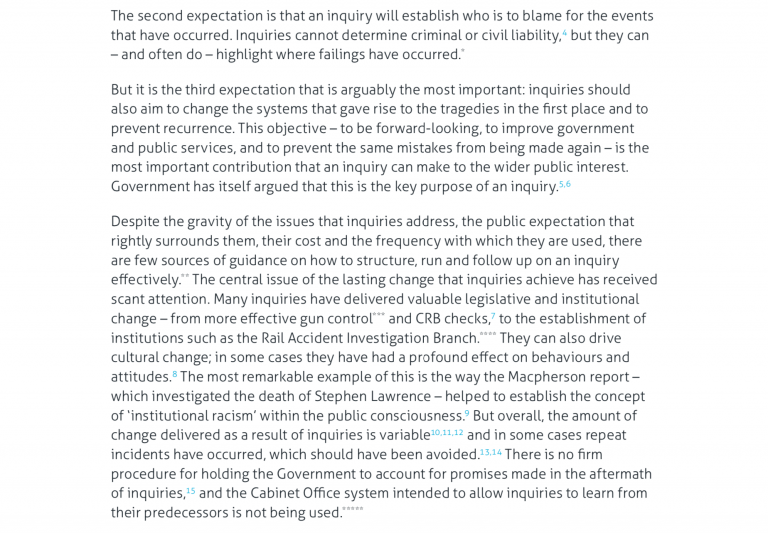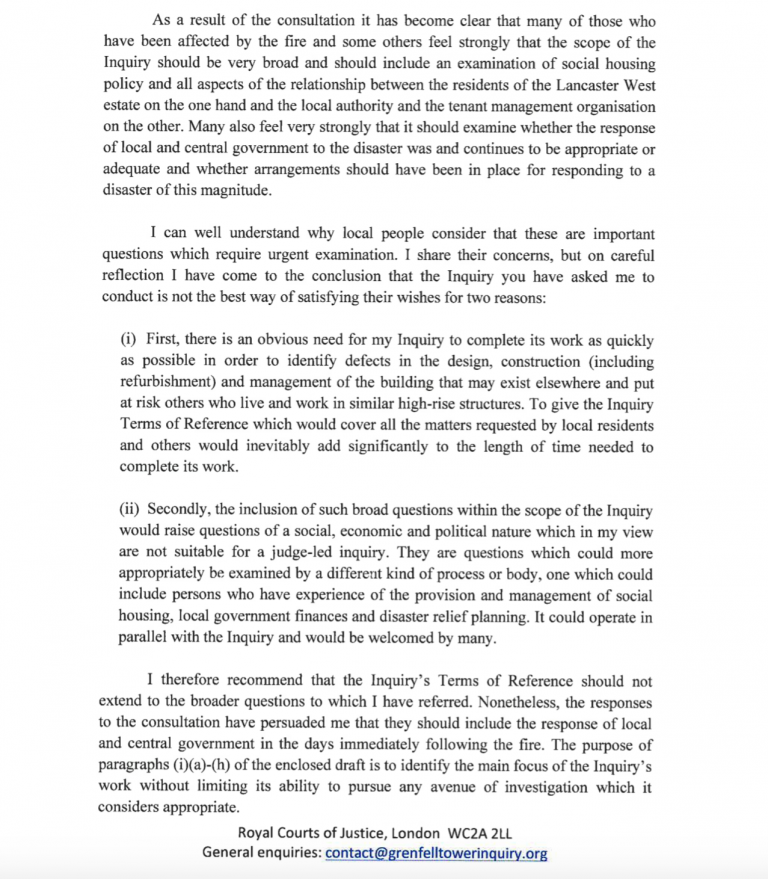The Grenfell Tower Inquiry: Key facts…
In preparation for the publication of the Phase 1 report, I’ve attempted to pull together some key facts about the Inquiry. Please forgive any errors or omissions.
I look at:
- The Purpose of a Public Inquiry
- The Grenfell Inquiry: Terms of Reference and Issues to be addressed
- The Grenfell Inquiry: Phase 1 and Phase 2
The Purpose of a Public Inquiry
In essence, Public Inquiries are the governments ‘investigation’ tool. They are not courts and cannot determine civil or criminal liability but they do serve the purpose of determining:
- What happened
- Why it happened (and who is to blame)
- How to prevent it occurring again.
The Institute for Government provides a good summary of the purpose and intent of Public Inquiries.

And, in another outstanding publication, the Institute for Government considers how Inquiries can lead to change. A couple of relevant extracts…


The Grenfell Tower Inquiry: Terms of Reference and Issues to be addressed
The Grenfell Tower Inquiry’s terms of reference were determined after a consultation process. Many think they are too narrow and should cover broader social and political issues. Sir Moore-Bick in his letter to the then Prime Minster Theresa May said:

| The Grenfell Inquiry Terms of Reference are: 1. To examine the circumstances surrounding the fire at Grenfell Tower on 14 June 2017, including: (a) the immediate cause or causes of the fire and the means by which it spread to the whole of the building; (b) the design and construction of the building and the decisions relating to its modification, refurbishment and management; (c) the scope and adequacy of building regulations, fire regulations and other legislation, guidance and industry practice relating to the design, construction, equipping and management of high-rise residential buildings; (d) whether such regulations, legislation, guidance and industry practice were complied with in the case of Grenfell Tower and the fire safety measures adopted in relation to it; (e) the arrangements made by the local authority or other responsible bodies for receiving and acting upon information either obtained from local residents or available from other sources (including information derived from fires in other buildings) relating to the risk of fire at Grenfell Tower, and the action taken in response to such information; (f) the fire prevention and fire safety measures in place at Grenfell Tower on 14 June 2017; (g) the response of the London Fire Brigade to the fire; and (h) the response of central and local government in the days immediately following the fire; and 2. To report its findings to the Prime Minister as soon as possible and to make recommendations. |
When announcing the terms of reference, Moore-Bick did say:
‘It is for me to interpret the terms of reference. The Inquiry is not limited to factual questions surrounding the development of the fire… It is my intention to look closely at the ways in which decisions relating to the modifications to the building were reached, including the considerations which motivated them. That will be an integral part of understanding how and why this fire occurred and of lessons learned for the future’. (page 18)
The list of issues to be investigated is laid out in the attached.

Two Phases
The inquiry is divided into 2 Phases. Phase 1 is limited to what happened on the night. Phase 2 will consider on ‘a broad front how the building came to be so seriously exposed to the risk of a disastrous fire.’
How I think about it is: Phase 1 is about what happened and Phase 2 is to understand why and how it happened.
Phase 1 (What happened: The night of the fire):
Phase 1 began with commemorative hearings for the 72 victims of the fire. These were followed by evidence from firefighters, survivors of the fire, expert witnesses, other stakeholders and ended with closing statements in December 2018.
The Phase 1 report is what will be published on the 30th October, 2019
All hearings are freely available on the Inquiry’s website.
Phase 2. (How and Why is happened):
The issues in Phase 2 will involve an investigation into the design of the building, it’s modification from time to time over previous years, the decisions relating to design and construction that were made in connection with each of those modifications and the reasons for those decision.
The updated list of issues (covering Phase 1 and 2) gives an indication of what will be covered.
The following is the Path to Phase 2 published by the Inquiry

The Phase 2 hearings will be organised into a series of modules according to key themes and encompassing the extensive range of issues that the Inquiry will be addressing in Phase 2. Phase 2 hearings will begin on 27 January 2020 with opening submissions followed by Module 1.
The table below outlines the modules anticipated in Phase 1.
| Module 1 | THE PRIMARY REFURBISHMENT (OVERVIEW AND CLADDING) |
| Module 2 | CLADDING PRODUCTS – TESTING/CERTIFICATION, PRODUCT MARKETING/PROMOTION |
| Module 3 | COMPLAINTS AND COMMUNICATION WITH RESIDENTS; MANAGEMENT OF BUILDING, COMPLIANCE RRO 2005, FIRE RISK ASSESSMENT; ACTIVE AND PASSIVE FIRE SAFETY MEASURES INTERNAL TO BUILDING. |
| Module 4 | AFTERMATH |
| Module 5 | FIREFIGHTING |
| Module 6 | GOVERNMENT |
| Module 7 | EXPERTS |
| Module 8 | EVIDENCE RELATING TO THE DECEASED |
Please reach out with any corrections…

